最新中考初中时间状语从句综合分析
- 格式:docx
- 大小:246.57 KB
- 文档页数:17
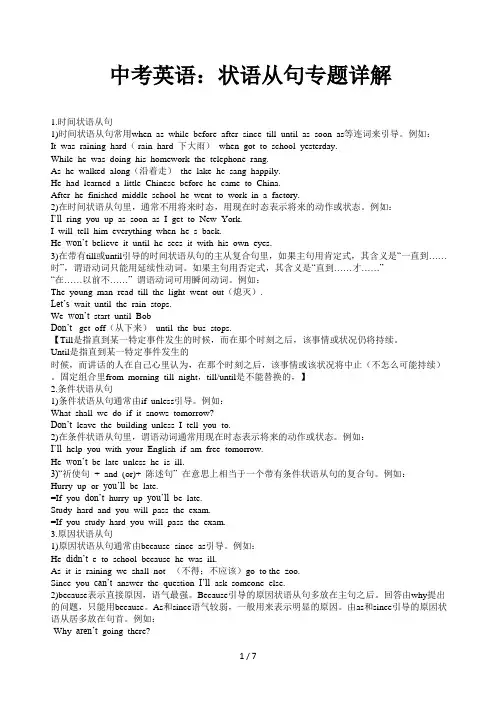
中考英语:状语从句专题详解1.时间状语从句1)时间状语从句常用when as while before after since till until as soon as等连词来引导。
例如:It was raining hard( rain hard 下大雨)when got to school yesterday.While he was doing his homework the telephone rang.As he walked along(沿着走)the lake he sang happily.He had learned a little Chinese before he came to China.After he finished middle school he went to work in a factory.2)在时间状语从句里,通常不用将来时态,用现在时态表示将来的动作或状态。
例如:I’ll ring you up as soon as I get to New York.I will tell him everything when he s back.He won’t believe it until he sees it with his own eyes.3)在带有till或until引导的时间状语从句的主从复合句里,如果主句用肯定式,其含义是“一直到……时”,谓语动词只能用延续性动词。
如果主句用否定式,其含义是“直到……才……”“在……以前不……”谓语动词可用瞬间动词。
例如:The young man read till the light went out(熄灭).Let’s wait until the rain stops.We won’t start until BobDon’t get off(从下来)until the bus stops.【Till是指直到某一特定事件发生的时候,而在那个时刻之后,该事情或状况仍将持续。
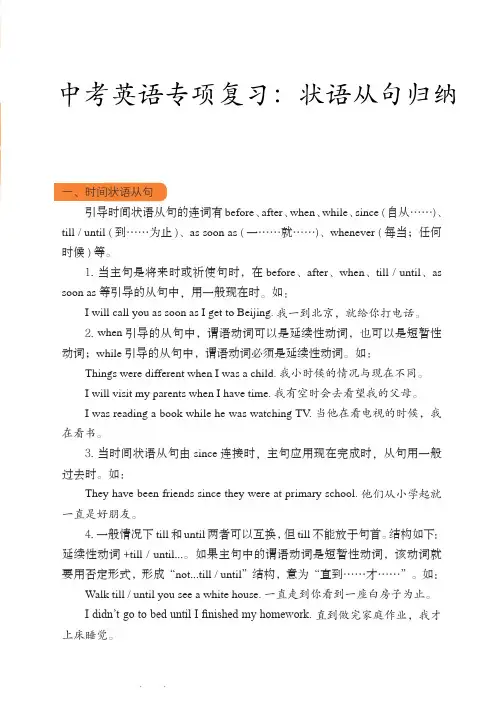
中考英语专项复习:状语从句归纳一、时间状语从句引导时间状语从句的连词有before、after、when、while、since (自从……)、till/until (到……为止)、as soon as (一……就……)、whenever (每当;任何时候)等。
1. 当主句是将来时或祈使句时,在before、after、when、till/until、as soon as等引导的从句中,用一般现在时。
如:I will call you as soon as I get to Beijing. 我一到北京,就给你打电话。
2. when引导的从句中,谓语动词可以是延续性动词,也可以是短暂性动词;while引导的从句中,谓语动词必须是延续性动词。
如:Things were different when I was a child. 我小时候的情况与现在不同。
I will visit my parents when I have time.我有空时会去看望我的父母。
I was reading a book while he was watching TV. 当他在看电视的时候,我在看书。
3. 当时间状语从句由since连接时,主句应用现在完成时,从句用一般过去时。
如:They have been friends since they were at primary school. 他们从小学起就一直是好朋友。
4. 一般情况下till和until两者可以互换,但till不能放于句首。
结构如下:延续性动词+till/until...。
如果主句中的谓语动词是短暂性动词,该动词就要用否定形式,形成“not...till/until”结构,意为“直到……才……”。
如:Walk till / until you see a white house. 一直走到你看到一座白房子为止。
I didn’t go to bed until I finished my homework. 直到做完家庭作业,我才上床睡觉。
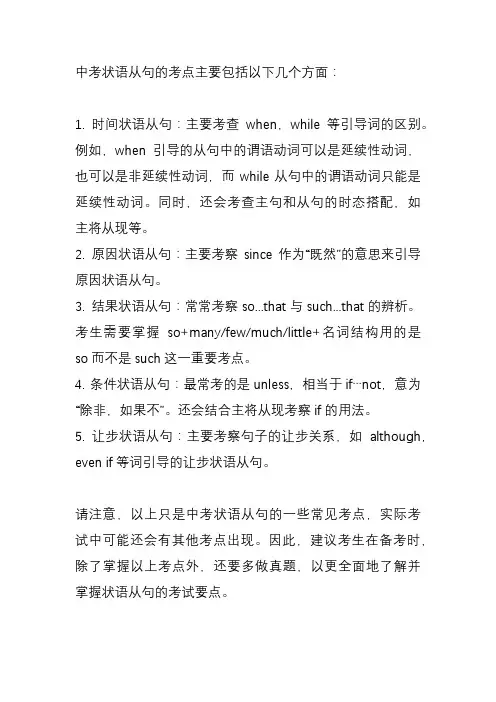
中考状语从句的考点主要包括以下几个方面:
1. 时间状语从句:主要考查when,while等引导词的区别。
例如,when引导的从句中的谓语动词可以是延续性动词,也可以是非延续性动词,而while从句中的谓语动词只能是延续性动词。
同时,还会考查主句和从句的时态搭配,如主将从现等。
2. 原因状语从句:主要考察since作为“既然”的意思来引导原因状语从句。
3. 结果状语从句:常常考察so...that与such...that的辨析。
考生需要掌握so+many/few/much/little+名词结构用的是so而不是such这一重要考点。
4. 条件状语从句:最常考的是unless,相当于if…not,意为“除非,如果不”。
还会结合主将从现考察if的用法。
5. 让步状语从句:主要考察句子的让步关系,如although,even if等词引导的让步状语从句。
请注意,以上只是中考状语从句的一些常见考点,实际考试中可能还会有其他考点出现。
因此,建议考生在备考时,除了掌握以上考点外,还要多做真题,以更全面地了解并掌握状语从句的考试要点。
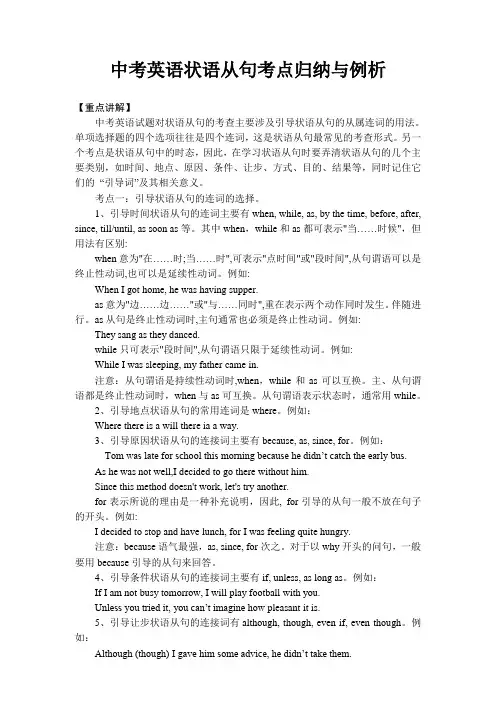
中考英语状语从句考点归纳与例析【重点讲解】中考英语试题对状语从句的考查主要涉及引导状语从句的从属连词的用法。
单项选择题的四个选项往往是四个连词,这是状语从句最常见的考查形式。
另一个考点是状语从句中的时态,因此,在学习状语从句时要弄清状语从句的几个主要类别,如时间、地点、原因、条件、让步、方式、目的、结果等,同时记住它们的“引导词”及其相关意义。
考点一:引导状语从句的连词的选择。
1、引导时间状语从句的连词主要有when, while, as, by the time, before, after, since, till/until, as soon as等。
其中when,while和as都可表示"当……时候",但用法有区别:when意为"在……时;当……时",可表示"点时间"或"段时间",从句谓语可以是终止性动词,也可以是延续性动词。
例如:When I got home, he was having supper.as意为"边……边……"或"与……同时",重在表示两个动作同时发生。
伴随进行。
as从句是终止性动词时,主句通常也必须是终止性动词。
例如: They sang as they danced.while只可表示"段时间",从句谓语只限于延续性动词。
例如:While I was sleeping, my father came in.注意:从句谓语是持续性动词时,when,while和as可以互换。
主、从句谓语都是终止性动词时,when与as可互换。
从句谓语表示状态时,通常用while。
2、引导地点状语从句的常用连词是where。
例如:Where there is a will there ia a way.3、引导原因状语从句的连接词主要有because, as, since, for。
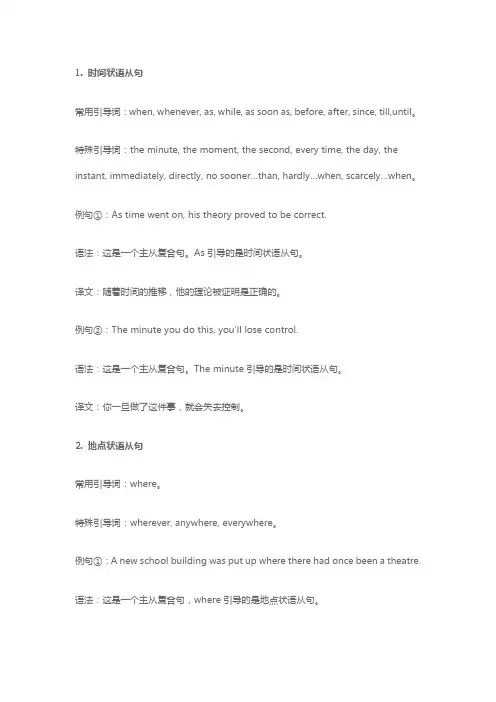
1. 时间状语从句常用引导词:when, whenever, as, while, as soon as, before, after, since, till,until。
特殊引导词:the minute, the moment, the second, every time, the day, the instant, immediately, directly, no sooner…than, hardly…when, scarcely…when。
例句①:As time went on, his theory proved to be correct.语法:这是一个主从复合句。
As引导的是时间状语从句。
译文:随着时间的推移,他的理论被证明是正确的。
例句②:The minute you do this, you'll lose control.语法:这是一个主从复合句。
The minute引导的是时间状语从句。
译文:你一旦做了这件事,就会失去控制。
2. 地点状语从句常用引导词:where。
特殊引导词:wherever, anywhere, everywhere。
例句①:A new school building was put up where there had once been a theatre. 语法:这是一个主从复合句,where引导的是地点状语从句。
译文:一所新的学校在以前的剧院处建成了。
例句②:Everywhere they went, the distinguished guests were warmly welcomed. 语法:这是一个主从复合句,Everywhere引导的是地点状语从句。
译文:贵宾们每到一处都受到了热烈欢迎。
3. 原因状语从句常用引导词:because, since, as, for。
特殊引导词:seeing that, now that, in that, considering that, given that。
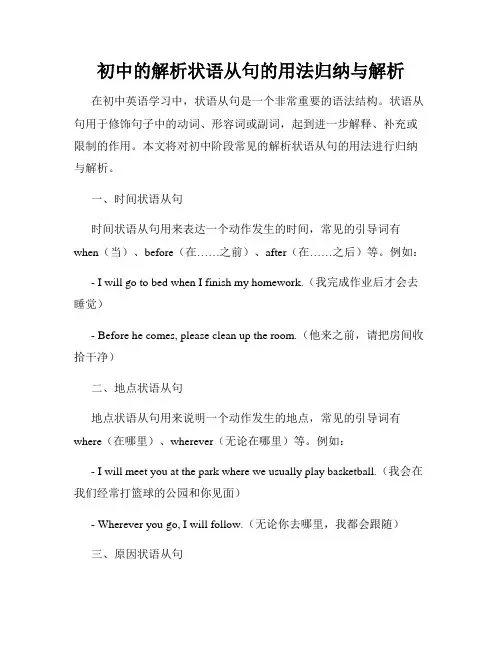
初中的解析状语从句的用法归纳与解析在初中英语学习中,状语从句是一个非常重要的语法结构。
状语从句用于修饰句子中的动词、形容词或副词,起到进一步解释、补充或限制的作用。
本文将对初中阶段常见的解析状语从句的用法进行归纳与解析。
一、时间状语从句时间状语从句用来表达一个动作发生的时间,常见的引导词有when(当)、before(在……之前)、after(在……之后)等。
例如:- I will go to bed when I finish my homework.(我完成作业后才会去睡觉)- Before he comes, please clean up the room.(他来之前,请把房间收拾干净)二、地点状语从句地点状语从句用来说明一个动作发生的地点,常见的引导词有where(在哪里)、wherever(无论在哪里)等。
例如:- I will meet you at the park where we usually play basketball.(我会在我们经常打篮球的公园和你见面)- Wherever you go, I will follow.(无论你去哪里,我都会跟随)三、原因状语从句原因状语从句用来解释为什么一个动作发生,常见的引导词有because(因为)、since(因为)等。
例如:- He didn't attend the meeting because he was sick.(他没参加会议,因为他生病了)- Since it's raining heavily, we'd better stay at home.(由于雨下得很大,我们最好待在家里)四、条件状语从句条件状语从句用来描述一个动作在满足特定条件时才能发生,常见的引导词有if(如果)、unless(除非)等。
例如:- If you study hard, you will pass the exam.(如果你努力学习,你会通过考试)- I won't go unless you come with me.(除非你和我一起去,否则我不会去)五、方式状语从句方式状语从句用来描述一个动作的方式或方式,常见的引导词有as (如)、as if(好像)、as though(好像)等。
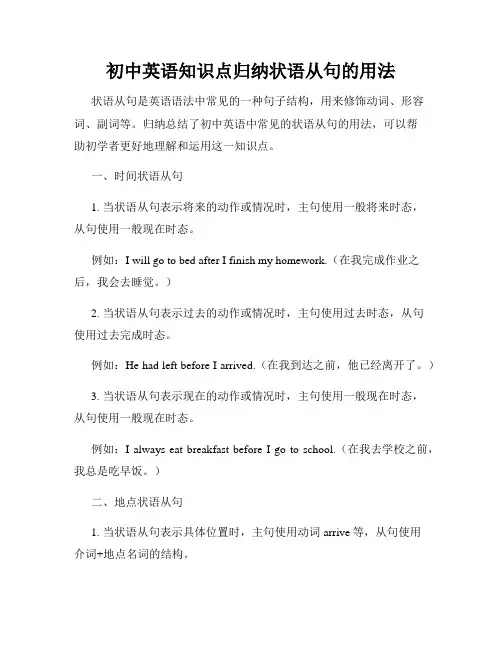
初中英语知识点归纳状语从句的用法状语从句是英语语法中常见的一种句子结构,用来修饰动词、形容词、副词等。
归纳总结了初中英语中常见的状语从句的用法,可以帮助初学者更好地理解和运用这一知识点。
一、时间状语从句1. 当状语从句表示将来的动作或情况时,主句使用一般将来时态,从句使用一般现在时态。
例如:I will go to bed after I finish my homework.(在我完成作业之后,我会去睡觉。
)2. 当状语从句表示过去的动作或情况时,主句使用过去时态,从句使用过去完成时态。
例如:He had left before I arrived.(在我到达之前,他已经离开了。
)3. 当状语从句表示现在的动作或情况时,主句使用一般现在时态,从句使用一般现在时态。
例如:I always eat breakfast before I go to school.(在我去学校之前,我总是吃早饭。
)二、地点状语从句1. 当状语从句表示具体位置时,主句使用动词arrive等,从句使用介词+地点名词的结构。
例如:We will meet at the place where we had lunch yesterday.(我们将在我们昨天吃午饭的地方见面。
)2. 当状语从句表示方向时,主句使用动词come/go等,从句使用连词where或标点符号将其与主句分开。
例如:He will go wherever you go.(无论你去哪儿,他都会去。
)三、原因状语从句1. 当状语从句表示结果时,主句使用so,主句中动词通常使用情态动词。
例如:I am ill, so I can't go to school.(我生病了,所以不能去学校。
)2. 当状语从句表示原因时,主句使用because,从句使用一般现在时态。
例如:He didn't eat breakfast because he got up late.(他早上起得晚,所以没有吃早饭。
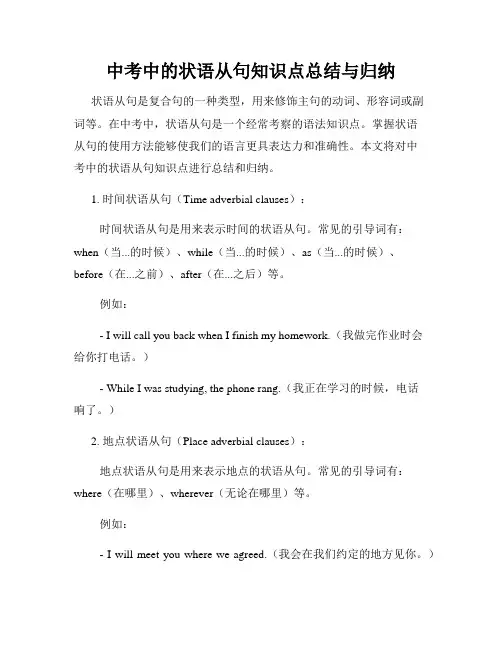
中考中的状语从句知识点总结与归纳状语从句是复合句的一种类型,用来修饰主句的动词、形容词或副词等。
在中考中,状语从句是一个经常考察的语法知识点。
掌握状语从句的使用方法能够使我们的语言更具表达力和准确性。
本文将对中考中的状语从句知识点进行总结和归纳。
1. 时间状语从句(Time adverbial clauses):时间状语从句是用来表示时间的状语从句。
常见的引导词有:when(当...的时候)、while(当...的时候)、as(当...的时候)、before(在...之前)、after(在...之后)等。
例如:- I will call you back when I finish my homework.(我做完作业时会给你打电话。
)- While I was studying, the phone rang.(我正在学习的时候,电话响了。
)2. 地点状语从句(Place adverbial clauses):地点状语从句是用来表示地点的状语从句。
常见的引导词有:where(在哪里)、wherever(无论在哪里)等。
例如:- I will meet you where we agreed.(我会在我们约定的地方见你。
)- Wherever you go, I will follow.(无论你去哪里,我都会跟随。
)3. 原因状语从句(Cause adverbial clauses):原因状语从句是用来表示原因的状语从句。
常见的引导词有:because(因为)、as(因为)、since(因为)、for(因为)、why(为什么)等。
例如:- I couldn't sleep because the room was too noisy.(因为房间太吵了,我睡不着。
)- He didn't come to the party, for he was not feeling well.(因为他身体不舒服,所以没来参加派对。
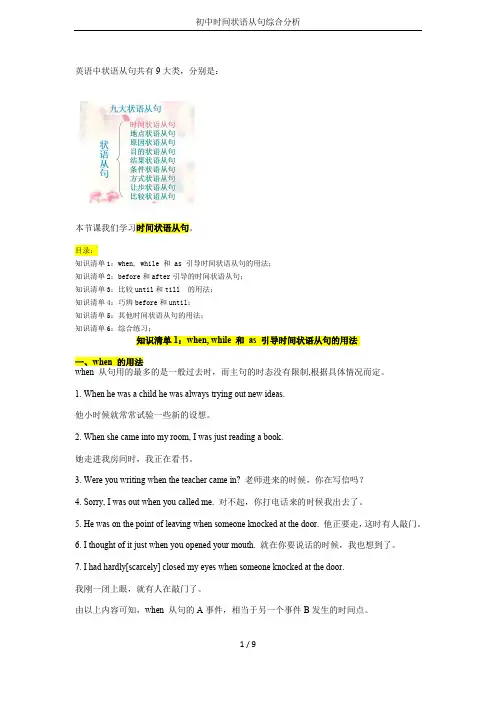
英语中状语从句共有9大类,分别是:本节课我们学习时间状语从句。
目录:知识清单1:when, while 和 as 引导时间状语从句的用法;知识清单2:before和after引导的时间状语从句;知识清单3:比较until和till 的用法;知识清单4:巧辨before和until;知识清单5:其他时间状语从句的用法;知识清单6:综合练习;知识清单1:when, while 和as 引导时间状语从句的用法一、when 的用法when 从句用的最多的是一般过去时,而主句的时态没有限制,根据具体情况而定。
1. When he was a child he was always trying out new ideas.他小时候就常常试验一些新的设想。
2. When she came into my room, I was just reading a book.她走进我房间时,我正在看书。
3. Were you writing when the teacher came in? 老师进来的时候,你在写信吗?4. Sorry, I was out when you called me. 对不起,你打电话来的时候我出去了。
5. He was on the point of leaving when someone knocked at the door. 他正要走,这时有人敲门。
6. I thought of it just when you opened your mouth. 就在你要说话的时候,我也想到了。
7. I had hardly[scarcely] closed my eyes when someone knocked at the door.我刚一闭上眼,就有人在敲门了。
由以上内容可知,when 从句的A事件,相当于另一个事件B发生的时间点。
也就是说,when 从句的重点不在动作本身发生的状态,而只是把它作为一个时间点,所以when 多数情况下用的是一般过去时,则不用正在进行时。
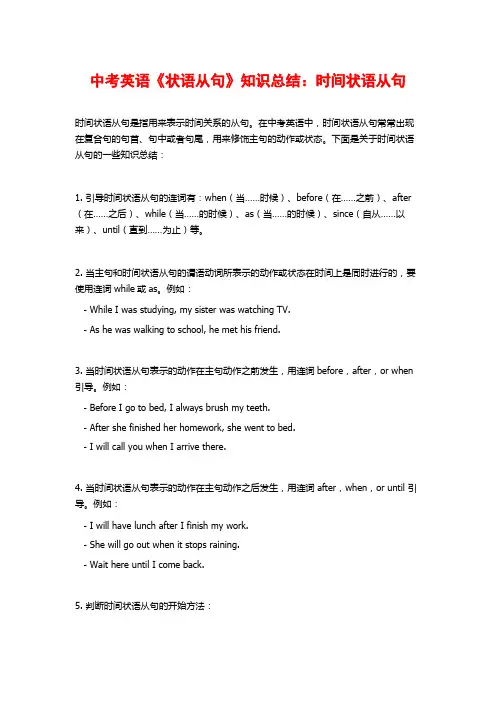
中考英语《状语从句》知识总结:时间状语从句时间状语从句是指用来表示时间关系的从句。
在中考英语中,时间状语从句常常出现在复合句的句首、句中或者句尾,用来修饰主句的动作或状态。
下面是关于时间状语从句的一些知识总结:1. 引导时间状语从句的连词有:when(当……时候)、before(在……之前)、after (在……之后)、while(当……的时候)、as(当……的时候)、since(自从……以来)、until(直到……为止)等。
2. 当主句和时间状语从句的谓语动词所表示的动作或状态在时间上是同时进行的,要使用连词while或as。
例如:- While I was studying, my sister was watching TV.- As he was walking to school, he met his friend.3. 当时间状语从句表示的动作在主句动作之前发生,用连词before,after,or when 引导。
例如:- Before I go to bed, I always brush my teeth.- After she finished her homework, she went to bed.- I will call you when I arrive there.4. 当时间状语从句表示的动作在主句动作之后发生,用连词after,when,or until 引导。
例如:- I will have lunch after I finish my work.- She will go out when it stops raining.- Wait here until I come back.5. 判断时间状语从句的开始方法:- 如果从句前面有句子是特殊疑问句(特殊疑问句一般用疑问词引导,如where, when, why, how),那么这个从句就是时间状语从句。
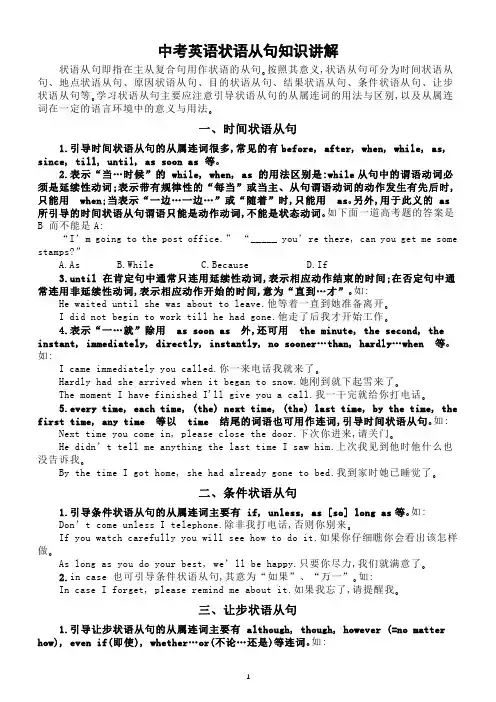
中考英语状语从句知识讲解状语从句即指在主从复合句用作状语的从句。按照其意义,状语从句可分为时间状语从句、地点状语从句、原因状语从句、目的状语从句、结果状语从句、条件状语从句、让步状语从句等。学习状语从句主要应注意引导状语从句的从属连词的用法与区别,以及从属连词在一定的语言环境中的意义与用法。一、时间状语从句1.引导时间状语从句的从属连词很多,常见的有before, after, when, while, as, since, till, until, as soon as 等。2.表示“当…时候”的 while, when, as 的用法区别是:while从句中的谓语动词必须是延续性动词;表示带有规律性的“每当”或当主、从句谓语动词的动作发生有先后时,只能用when;当表示“一边…一边…”或“随着”时,只能用as。另外,用于此义的 as 所引导的时间状语从句谓语只能是动作动词,不能是状态动词。如下面一道高考题的答案是B 而不能是A:“I’m going to the post office.” “_____ you’re there, can you get me some stamps?”A.AsB.WhileC.BecauseD.If3.until 在肯定句中通常只连用延续性动词,表示相应动作结束的时间;在否定句中通常连用非延续性动词,表示相应动作开始的时间,意为“直到…才”。如:He waited until she was about to leave.他等着一直到她准备离开。I did not begin to work till he had gone.他走了后我才开始工作。4.表示“一…就”除用as soon as 外,还可用the minute, the second, the instant, immediately, directly, instantly, no sooner…than, hardly…when等。如:I came immediately you called.你一来电话我就来了。Hardly had she arrived when it began to snow.她刚到就下起雪来了。The moment I have finished I'll give you a call.我一干完就给你打电话。5.every time, each time, (the) next time, (the) last time, by the time, the first time, any time 等以time 结尾的词语也可用作连词,引导时间状语从句。如: Next time you come in, please close the door.下次你进来,请关门。He didn’t tell me anything the last time I saw him.上次我见到他时他什么也没告诉我。By the time I got home, she had already gone to bed.我到家时她已睡觉了。二、条件状语从句1.引导条件状语从句的从属连词主要有 if, unless, as [so] long as等。如:Don’t come unless I telephone.除非我打电话,否则你别来。If you watch carefully you will see how to do it.如果你仔细瞧你会看出该怎样做。As long as you do your best, we’ll be happy.只要你尽力,我们就满意了。2.in case 也可引导条件状语从句,其意为“如果”、“万一”。如:In case I forget, please remind me about it.如果我忘了,请提醒我。三、让步状语从句1.引导让步状语从句的从属连词主要有 although, though, however (=no matter how), even if(即使), whether…or(不论…还是)等连词。如:The speech is good, though it could be better.这次演讲不错,虽然还可以再好一点。He went out even though it was raining.尽管下雨,他还是出去了。2.as 也可引导让步状语从句,但要将名词、形容词或副词等提到as 前,若提前的是单数可数名词,要省略 a / an。如:Teacher as he is, he can’t know everything.虽然是老师,他也不可能什么都懂。3.连词 while 有时也可表示“尽管”、“虽然”,引导让步状语从句。如:Wh ile we don’t agree we continue to be friends.尽管我们意见不同,我们还是朋友。4.whatever, whoever, however, whenever, wherever 等引导让步状语从句。如:Don’t lose heart whatever you do.不管你做什么,都不要灰心。Whoever you are, you can’t pass this way.不管你是谁,你都不能从这里通过。注:表示“虽然”的though, although 不可与but 连用,但可与yet,still 连用。四、原因状语从句1.引导原因状语从句的从属连词主要有because, as, since, seeing (that), now (that)等:They can’t have gone out because the light’s on.他们不可能出去了,因为灯还亮着。Since you are going, I will go.既然你去,我也去。Now that we are alone, we can speak freely.现在我们单独在一起,可以随便谈了。2.除以上提到的大家比较熟悉的引导原因状语从句的从属连词外,when有时也可引导原因状语从句,其意“既然”。如:I can’t tell you when you won't listen.既然你不想听,我就不告诉你了。3.有关原因状语从句还应注意以下几点:(1) as 与since, now that 一样表示双方都知道的原因,通常位于主句前,且均不可用于强调结构被强调。(2) 当表示直接的因果关系,回答why 时,或有only, just, all, partly, not, but 等副词修饰时,或用在强调结构中都只能用because。(3) for 有时也可引出表示原因的分句,但它只能位于后面,对前一分句加以解释或推断。(4) 不要受汉语意思影响将表示“因为”的连词与表示“所以”的so 连用。五、地点状语从句引导地点状语从句的从属连词主要有where (在…的地方), wherever(无论什么地方), everywhere(每个…地方), anywhere(任何…地方)。如:I’m not living where I was.我不在原处住了。You can’t camp where [wherever, anywhere] you like these days.如今你可不能随便在哪儿宿营。Everywhere I go, I find the same thing.不管我走到哪里,我都发现同样情况。2.有的同学认为地点状语从句在平时见得不多,误认为考试不会涉及,但恰恰相反,地点状语从句却是英语考试经常考查的一个知识点。请看以下考题:(1) When you read the book, you’d better make a ma rk _____ you have any questions.A.at whichB.at whereC.the place whereD.where(2) After the war, a new school building was put up _____ there had once beena theatre.A.thatB.whereC.whichD.when(3) You should make it a rule to leave things _____ you can find them again.A.whenB.whereC.thenD.there(4) She found her calculator ______ she lost it.A.whereB.whenC.in whichD.that以上四题均选where,其意为“在…的地方”,用以引导地点状语从句。六、目的状语从句1.引导目的状语从句的从属连词主要有in order that, so that, in case, for fear 等。如:I hired a boat so that I could go fishing.我租了一条船去钓鱼。Take your coat in case it rains (should rain).带着雨衣以防下雨。He studied hard in order that he could pass the exam.他努力学习,是为了能通过考试。2.引导目的状语从句的so that 有时可省so 或that,即单独用so 或that 来引导目的状语从句。如:Check carefully, so any mistake will be caught.仔细检查,以便任何错误都可检查出。Bring it closer that I might see it better.拿近些,使我能看得清楚些。七、结果状语从句引导结果状语从句的从属连词主要有so that, so…that, such…that等。如:He was so angry that he couldn't speak.他气得话都说不出来。He shut the window with such force that the glass broke.他关窗子用力很大,结果玻璃震破了。注:so…that和such…that中的that有时(尤其在口语中)可省略。八、比较状语从句引导比较状语从句的从属连词为as...as(和……一样),not as/so...as(和……不一样),than(比),the more...the more(越……越)。这类从句常以省略形式出现。如: The work is not so difficult as you imagine.这工作不像你想像的那么困难。You look younger than you are.你看上去比你的实际年龄要年轻。The more you study, the more knowledge you can get.你学的知识越多,你的知识越丰富。He doesn’t work as hard as she (does).他工作不像她那样努力。九、方式状语从句引导方式状语从句的从属连词有as(正如),as if或as though(好像)等。如:Do as I told you.按我告诉你的那样做。As a man lives, so he dies.正如人能活,也能死。I remember the whole thing as if it happened yesterday.整个这件事我记得很清楚,就仿佛是昨天发生似的。注:口语中like也可用连词引导方式状语从句。如:Do it like he does.照他那样做。She can’t cook like her mother does.她菜做得没有她妈那样好。。
中考英语《状语从句》知识总结:时间状语从句
为您整理“中考英语《状语从句》知识总结:时间状语从句”,欢迎阅读参考,更多有关内容请继续关注本网站中考栏目。
中考英语《状语从句》知识总结:时间状语从句
时间状语从句常用从属连词when,after,until,as soon as,等来引导。
当主句是祈使句或谓语动词是一般将来时态或情态动词时,其时间状语从句中的谓语动词常用一般现在时态表示将来发生的动作或存在的状态。
这就是我们常说的“主将从现”。
如:Please call me when you get there.当你到那时,请给我打个电话。
I will write to you as soon as I arrive in Beijing.我一到北京就给你写信。
<温馨提示>since引导时间状语从句表示“自从…以来”,从句中的动词一般表示动作的起点,用过去时;而主句的动作延续的情况则用一般现在时或现在完成时。
常用的句型为:
It has been/is+一段时间+since+过去时。
如:I has been/is three years since we met last time.自从我们上次见面,已经三年了。
中考初中时间状语从句综合分析本节课我们学习时间状语从句。
目录:知识清单 1:when, while和 as引导时间状语从句的用法;知识清单 2:before 和 after 引导的时间状语从句;知识清单 3:比较 until和 till的用法;知识清单 4:巧辨 before和 until;知识清单 5:其他时间状语从句的用法;知识清单 6:综合练习;知识清单1: when, while 和 as 引导时间状语从句的用法一、 when 的用法when 从句用的最多的是一般过去时,而主句的时态没有限制,根据具体情况而定。
1. When he was a child he was always trying out new ideas.他小时候就常常试验一些新的设想。
2. When she came into my room, I was just reading a book.她走进我房间时,我正在看书。
3.Were you writing when the teacher came in? 老师进来的时候,你在写信吗?4.Sorry, I was out when you called me. 对不起,你打电话来的时候我出去了。
5.He was on the point of leaving when someone knocked at the door. 他正要走,这时有人敲门。
6.I thought of it just when you opened your mouth. 就在你要说话的时候,我也想到了。
7.I had hardly[scarcely] closed my eyes when someone knocked at the door.我刚一闭上眼,就有人在敲门了。
由以上内容可知,when 从句的 A 事件,相当于另一个事件 B 发生的时间点。
也就是说, when 从句的重点不在动作本身发生的状态,而只是把它作为一个时间点,所以when 多数情况下用的是一般过去时,则不用正在进行时。
初中英语状语从句的使用与考点汇总状语从句是初中英语语法中的重要内容,它在句子中充当状语,用于修饰动词、形容词、副词或整个句子。
掌握状语从句的使用对于提高英语语言表达的准确性和丰富性具有重要意义。
下面我们就来详细探讨一下初中英语中常见的状语从句类型、使用方法以及考点。
一、时间状语从句时间状语从句表示时间关系,常用的引导词有 when(当时候)、while(在期间)、as(当时;一边一边)、before(在之前)、after (在之后)、since(自从)、until / till(直到)等。
1、 when 引导的时间状语从句when 表示“当时候”,从句中的动作可以与主句的动作同时发生,也可以先于主句的动作发生。
例如:When I was a child, I often played football (当我还是个孩子的时候,我经常踢足球。
)When she came in, I was reading a book (当她进来的时候,我正在读书。
)2、 while 引导的时间状语从句while 表示“在期间”,强调主句动作和从句动作在同一时间段内同时发生,且从句中的动作通常是持续性的。
例如:While I was doing my homework, my mother was cooking (当我在做作业的时候,我妈妈在做饭。
)3、 as 引导的时间状语从句as 表示“当时;一边一边”,强调两个动作同时发生,且动作具有延续性。
例如:As she walked along the street, she sang happily (她一边沿着街道走,一边高兴地唱歌。
)4、 before 和 after 引导的时间状语从句before 表示“在之前”,after 表示“在之后”。
例如:I had finished my homework before my father came back (我在我爸爸回来之前就完成了作业。
九年级英语时间状语从句语法规律总结1.when 引导的时间状语从句when(当……时候)引导的从句,从句中的动词可以是终止性动词,也可以是持续性动词。
在when引导的时间状语从句中,当主句表示将来时,从句用一般现在时表示将来.I want to be a teacher when I grow up .长大后我想成为一名教师。
2.while引导的时间状语从句While(当……时候)引导的从句,强调主从句的动作同时发生或主句动作在从句动作持续过程中的某一时刻发生。
从句中的谓语动词应用延续性动词或表状态的词,并且从句常用进行时态。
I met Anne while I was taking a walk in the park.我在公园散步时遇到了安妮。
3.as soon as 引导的时间状语从句as soon as引导时间状语从句,表示“一……就……”。
主句和从句的动作几乎在同时发生,或间隔时间很短。
如果主句用一般将来时,那么从句用一般现在时表示将来。
Please call me up as soon as you arrive there.请你一到那儿就给我打电话。
4.before/after 引导的时间状语从句before(在……之前)引导的时间状语从句一般表示主句的动作发生在从句动作之前。
after (在……之后)引导的时间状语从句一般表示主句的动作发生在从句动作之后。
He will come to see you before he leaves Beijing.他离开北京之前会来看你的。
After she locked the door ,she left.她锁上门之后就走了。
5. until 引导的时间状语从句until(直到……)当其用于肯定句时,表示主句的动作一直持续到until从句所表示的时间,即表示动作的终点,谓语动词必须是持续性动词,如live, wait, stay等。
当其用于否定句时,表示主句的动作直到until从句所表示的时间才发生,即表示动作的起点,谓语动词为延续性或非延续性动词均可。
中考英语一轮复习状语从句考点聚焦精讲及练习(含解析)用来修饰主句中的动词,副词,形容词或整个句子的从句叫状语从句。
根据其含义状语从句可分为时间状语从句,条件状语从句,原因状语从句,结果状语从句,比较状语从句,目的状语从句,让步状语从句,地点状语从句,方式状语从句。
状语从句都由从属连词引导,与主句连接,放在句末时,一般不在前面加逗号。
1.时间状语从句(1)时间状语从句表示时间,常用when;while;as;before;after;since;till/until;as soon as等连词来引导。
时间状语从句中的谓语动词不能用一般将来时,只能用一般现在时表示将来发生的动作或存在的状态。
1.When I got home,he was having supper.当我回到家的时候,他正在吃饭。
2.When he reached home,he had a little rest.回到家以后,他休息了一会儿。
3.When she came into my room,I was just reading a book.她走进我房间时,我正在看书。
1.Please listen to me carefully while I read.我读的时候请认真听。
2.I can listen to the radio while I work.我可以边听收音机边工作。
3.While I was sleeping,my father came in.我睡觉时,我的父亲进来了。
4.Father was cleaning the car while I was playing computer games.当我正在打电脑游戏时,爸爸在清洗汽车。
引导的时间状语从句,表示的是一件事情正在发生,另一件事也正在进1.The little girls sang as they went.小姑娘们一边走,一边唱。
2.The students took notes as they listened.学生们边听课边做笔记。
2024年初中英语语法学习之状语从句精讲英语状语从句是英语学习中的一个重要考点,下面将针对英语状语从句进行考点归纳。
一、时间状语从句时间状语从句是语法中的一个重要考点,下面是一些常见的时间状语从句:when:表示某个时间点或时间段,如“I will arrive at the airport when the plane takes off.”before:表示某个时间点或时间段之前,如“I will eat breakfast before I go to work.”after:表示某个时间点或时间段之后,如“I will finish my homework after I have dinner.”while:表示某个时间点或时间段持续,如“I was studying while she was sleeping.”as soon as:表示某个时间点或时间段一过去就发生,如“I will call you as soon as I get home.”until:表示某个时间点或时间段一直持续,如“I won't leave until I have finished my work.”since:表示某个时间点或时间段以来,如“I have been living in this city since I moved here last year.”when/while/as:这些词都可以引导时间状语从句,但它们的使用略有不同,需要根据具体语境选择使用哪个。
需要注意的是,如果主句是一般将来时,从句只能用一般现在时,如“I will go to the store tomorrow”中的“tomorrow”就是时间状语从句。
二、地点状语从句地点状语从句是语法中的一个重要考点,下面是一些常见的地点状语从句: where:表示某个地点,如“I will go to the store where I bought the groceries.”that:表示某个地点或位置,如“I saw a beautiful sunset over that mountain.”which:表示某个地点或位置,如“The building which is on fire needs to be evacuated immediately.”where/that/which:这些词都可以引导地点状语从句,但它们的使用略有不同,需要根据具体语境选择使用哪个。
中考初中时间状语从句综合分析本节课我们学习时间状语从句。
目录:知识清单1:when, while 和 as 引导时间状语从句的用法;知识清单2:before和after引导的时间状语从句;知识清单3:比较until和till 的用法;知识清单4:巧辨before和until;知识清单5:其他时间状语从句的用法;知识清单6:综合练习;知识清单1:when, while 和as 引导时间状语从句的用法一、when 的用法when 从句用的最多的是一般过去时,而主句的时态没有限制,根据具体情况而定。
1. When he was a child he was always trying out new ideas.他小时候就常常试验一些新的设想。
2. When she came into my room, I was just reading a book.她走进我房间时,我正在看书。
3. Were you writing when the teacher came in? 老师进来的时候,你在写信吗?4. Sorry, I was out when you called me. 对不起,你打电话来的时候我出去了。
5. He was on the point of leaving when someone knocked at the door. 他正要走,这时有人敲门。
6. I thought of it just when you opened your mouth. 就在你要说话的时候,我也想到了。
7. I had hardly[scarcely] closed my eyes when someone knocked at the door.我刚一闭上眼,就有人在敲门了。
由以上内容可知,when 从句的A事件,相当于另一个事件B发生的时间点。
也就是说,when 从句的重点不在动作本身发生的状态,而只是把它作为一个时间点,所以when 多数情况下用的是一般过去时,则不用正在进行时。
因为如果用正在进行时,它表示的就是一段时间而不是一个时间点了。
实际上,when 从句也可以有其它的时态,但几乎也不用进行时,因为它也只是作为一个时间参照点。
例如:1. When I got to the airport, the guests had left.当我赶到飞机场时,客人们已经离开了。
2. When he had finished his homework, he took a short rest.当他完成作业后,他休息了一会儿。
3. Why do you want a new job when you have got such a good one already?你已经找到如此好的工作,为何还想再找新的?4. You shall borrow the book when I have finished reading it.在我读完这本书后,你可以借阅。
5. When the manager comes here for a visit next week, I’ll talk with him about this.下周,经理来这参观时,我会和他谈谈此事。
二、while 的用法相比于when 来说,while 从句的侧重点就不一样了。
while 从句的侧重点在于描述动作正在发生的状态,它的意思是:当while 事件正在发生的时候,另一件事如何如何。
所以,while 从句一般用的是正在进行时。
而另一件事的状态没有硬性的要求,根据具体情况而定。
例如:1. While my wife was reading the newspaper, I was watching TV.当妻子正在看报纸的时候,我正在看电视。
2. While Jim was mending his bike, Lin Tao came to see him.正当吉姆修自行车时,林涛来看他。
3. While they were talking, the bell rang. 正在他们谈话的时候,上课铃响了。
4. You can’t do your homework while you’re watching TV.你不能一边看电视一边做家庭作业。
5. While John was sitting biting his nails, I was working out a plan to get us home.约翰坐在那里咬指甲时,我正在制定一个回家的计划。
从时间的角度来看,while 表示的是一段时间,是一个过程。
这是while 的侧重点。
因此,如果含有“一段时间”的含义的时候,就可以用while。
6. Strike while the iron is hot. 趁热打铁。
这句话中,是说趁着铁是热的这段时间,赶紧打铁。
如果换成 when 意思就变了,相当于说铁只热了一下,打一下,然后铁就冷了。
这显然不符合文意。
再例:—I'm going to the post office.—While you're there, can you get me some stamps?三、 as 的用法as 从句表示的也是一件事情正在发生,另一件事也正在进行当中。
但与 while 从句不同的是,as 从句用的一般不用正在进行时,而只是一般过去时。
as 从句一般可以翻译成“边……边……”。
例如:1. As my mother sang those old songs, tears ran down her cheeks.当我妈妈唱起那些老歌时,眼泪顺着她的脸颊流了下来。
2. The students took notes as they listened. 学生们边听课边做笔记。
3. As we talked on, he got more and more excited.我们继续往下谈的时候,他越来越兴奋。
4. The little girls sang as they went. 小姑娘们一边走,一边唱。
5. Just as he caught the ball, there was a tearing sound.当他抓住球的时候,有一种撕裂的声音。
as 表达的事件,往往只是主句动作发生的背景或条件时,as 只是一个次要的时间说明,不像while 从句有强调 while 动作本身的意思。
因此,as 常常翻译成“随着……”之意。
例如:1. As the time went on,the weather got worse. 随着时间的推移,气候更加糟糕。
2. The atmosphere gets thinner and thinner as the height increases.随着高度的增加,大气越来越稀薄。
3. As years go by,China is getting stronger and richer.随着时间一年一年过去,中国变得越来越富强了。
少数情况下,如果强调动作正在发生,as 从句也可以用正在进行时。
这只能算是特例了。
1. The sad mother sat on the roadside, shouting as she was crying.伤心的妈妈坐在路边,边哭边叫喊。
2. As we were going out, it began to snow. 正当我们出门时,雪开始下起来。
3. He came in as I was going to bed. 我正要上床睡觉,他进来了。
四、 when, while, as 的互换如果从句动作和主句动作同时发生,并且从句动作为延续性动词时,when,while,as 可以互换使用。
1. When /While /As we were dancing, a stranger came in.当我们跳舞时,一位陌生人走了进来。
[dance 为延续性动词]2. When /While /As she was making a phone call, I was writing a letter.当她在打电话时,我正在写信。
[make为延续性动词]3. While/When/ As I was walking down the street, I noticed a police car in front of the bank.我顺着马路往前走时,发现银行门前停着一辆警车。
五、比较while, when, as1)as, when 引导短暂性动作的动词。
例如:Just as / Just when / When I stopped my car, a man came up to me.我刹车后,有一个人向我走来。
2)当从句的动作发生于主句动作之前,只能用when 引导这个从句,不可用as 或 while。
例如:When you have finished your work, you may have a rest. 干完活后,你可以休息一下。
3)从句表示“随时间推移”连词能用as,不用when 或while。
例如: As the day went on, the weather got worse.日子一天天过去,天气越变越坏。
知识清单2:before和after引导的时间状语从句1. Before是主句动作发生在从句的前面。
注意before引导的从句不再用否定式的谓语,并且当before引导的从句位于主句之后,有时译成“就,才”。
还要注意主句和从句之间的时间关系。
当主句用将来时,从句总是用现在时;如果before 引导的从句谓语用的是过去时,则主句动词多用过去完成时,这样以便体现动作发生的先后。
2. After表示主句动作发生在从句动作之后。
主句和从句的动作的时间关系正好与before引导的从句相反。
例如:It will be four days before they come back. 他们要过四天才能回来。
Einstein almost knocked me down before he saw me.爱因斯坦几乎把我撞倒才看到我。
My father had left for Canada just before the letter arrived.我父亲恰好在信到之前去加拿大了。
They had not been married four months before they were divorced.他们结婚还不到四个月就离婚了。
After you think it over, please let me know what you decide.你仔细考虑过以后,告诉我你是怎样决定的。